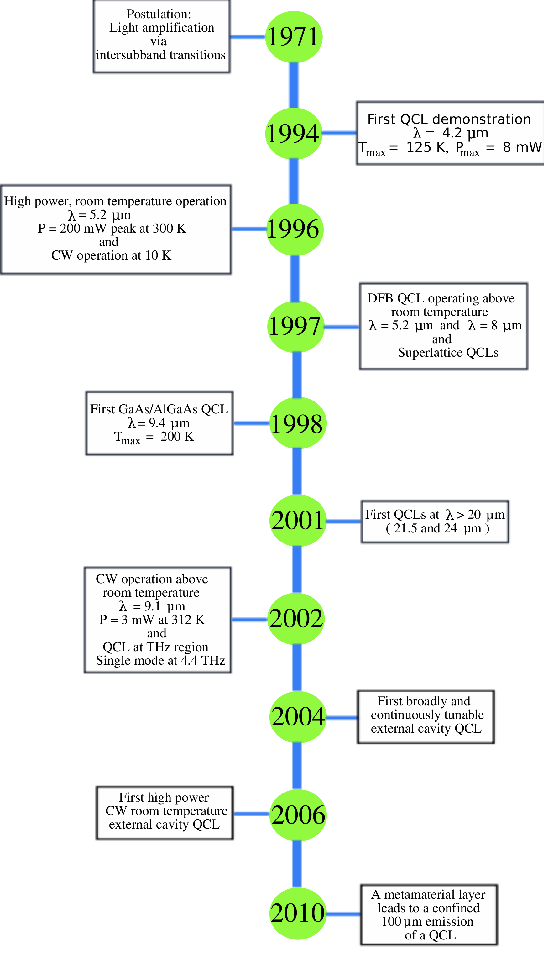
Progress advanced quickly after the first demonstration of an intersubband laser in 1994, designed in the Bell Laboratories to emit at 4.2 μm wavelength with peak powers in excess of 8 mW in pulsed operation and grown by molecular beam epitaxy [8]. This progress is facilitated basically by the advance in growth techniques and by the improving understanding of bandstructure engineering, resulting in a better control of the electron transport to enable an increase in population inversion and gain. A timeline of the most important achievements is shown in Figure 2.2.
In 1996, MIR QCLs were created that reach a high pulsed power at temperatures up to 320 K and a continuous wave (CW) operation up to 140 K [18]. An active region based on a three-well vertical transition design and a funnel injector were used to optimize the gain. At 300 K a peak pulsed optical power of 200 mW was obtained, where the emission wavelength was about 5.2 μm. In the same year, long wavelength single-mode QCLs based on an AlInAs/GaInAs heterostructure emitting at 11.2 μm were established [19]. Moreover, a continuous wave operation with powers of about 7 mW at a temperature of 10 K was sucessfully obtained.
One year later, a continuously tunable single-mode laser was provided by a distributed feedback (DFB) QCL operating above room temperature at 5.4 and 8 μm wavelengths [20]. Due to the alternating refractive index the periodically structured active region acts as a diffraction grating, where the wavelength is determined by the Bragg reflection condition. In the same year, a long wavelength QCL based on a superlattice active region was demonstrated [21]. An intrinsic inversion is achieved by minibands in the active region. Electrons injected by tunneling emit photons corresponding to the energy separation.
The first GaAs/AlGaAs QCL was reported in 1998 [9]. This work demonstrated the validity of QCL principles in a heterostructure material system different from the system InGaAs/AlInAs on InP used before. This QCL structure employed 33 % Al in the barriers and emitted at a wavelength of 9.4 μm under pulse operation up to 140 K. The threshold current density of this device was reduced to an average of 5 kA/cm2 at 77 K, and a maximum pulsed operation temperature of about 200 K was achieved with a low loss Al-free waveguide [22]. Since the first realization of GaAs/Al0.45 Ga0.55As QCLs [23] the device performance has improved significantly. For several active region designs a room temperature pulsed operation has been demonstrated, e.g. a superlattice active region design with an emission wavelength at 12.6 μm [24] and a bound-to-continuum design emitting at 82 μm [25]. Recently, a continuous wave operation with a maximum temperature of 150 K has been achieved due to optimized device processing [26].
The first QCLs with wavelengths larger than 20 μm, in particular at 21.5 and 24 μm, were reported in 2001 [27]. Originating from interminiband transitions in superlattice active regions, laser action is achieved up to 140 K with a peak power of a few mW. The structures were grown by molecular beam epitaxy using an In0.53Ga0.47As/Al0.48In0.52As lattice matched to an InP substrate. Up to this time, these semiconductor lasers had the longest emission wavelength.
One year later, a continuous wave operation of a MIR semiconductor laser above room temperature was demonstrated [28]. At an emission wavelength of 9.1 μm, the optical output power ranged from 17 mW at 292 K to 3 mW at 312 K. In the same year, a prototype of a QCL emitting in the THz region (30 - 300 μm) was reported [29]. Emitting a single mode at 4.4 THz, the device reached an output power of more than 2 mW.
Further notable milestones are the first broudly and continuously tunable external cavity QCL in 2004 [30], and the first high power CW external cavity QCL at room temperature [31].
In 2010, a 100 μm emission of a QCL to a 10∘ cone was reported [32]. Due to fabricating a metamaterial layer on the output facet, the heavily doped semiconductor acts like a metal at terahertz frequencies.
Nowadays, QCLs operate over a wide wavelength range of 2.9 - 250 μm [33]. Spanning the MIR and THz region, they also operate at room temperature and in continuous wave mode with up to 3 W of optical power.